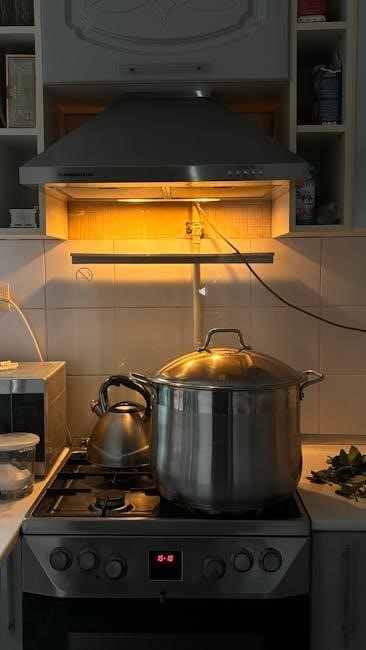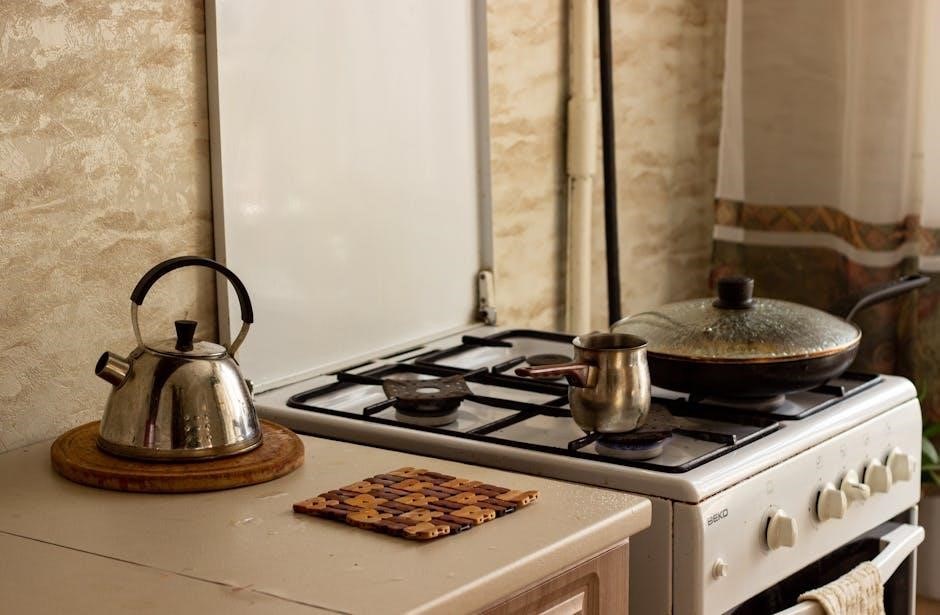Swift 500 Series Oven Manual: Article Plan (21 Headings/Subheadings)
This document outlines the comprehensive guide for the Swift 500 series cooker, encompassing installation, operation, maintenance, and troubleshooting – adhering to ASNZ5601 standards․
The Swift 500 series cooker provides reliable cooking functionality, designed for caravan, motorhome, and holiday home use; detailed instructions ensure safe and efficient operation for all users․
Overview of the Swift 500 Series Cooker
The Swift 500 series cooker is a popular choice for compact kitchens, particularly within caravans, motorhomes, and holiday homes․ It’s designed to offer a balance of functionality and space-saving design․ This appliance incorporates both oven and hob capabilities, providing versatile cooking options․ Users can expect a standard oven capacity suitable for typical household cooking needs․
Key features include multiple oven functions, such as conventional and fan-assisted modes, alongside a grill function for added versatility․ The cooker’s dimensions are approximately 500(W) x 600(D) x 900(H) mm, making it suitable for smaller spaces․ Swift Group provides replacement parts and supports compliance with relevant safety standards like ASNZ5601 for gas installations․ Proper installation and adherence to the instruction manual are crucial for safe and efficient operation․
Intended Use and Safety Precautions
The Swift 500 Series cooker is designed for normal domestic cooking purposes within a caravan, motorhome, or holiday home environment․ It is not intended for commercial use․ Crucially, users must read this instruction manual before operating the appliance to ensure safe and correct usage․
Safety precautions include ensuring proper ventilation during gas operation and never obstructing ventilation openings․ Do not use the cooker until it’s correctly installed and compliant with ASNZ5601 gas installation regulations․ Regular cleaning is essential to prevent grease build-up, a potential fire hazard․ Never attempt to repair the cooker yourself; contact Swift Group for replacement parts and qualified servicing․ Always disconnect the gas supply before maintenance․ Failure to follow these precautions could result in injury or damage․

Unpacking and Installation
Carefully inspect the Swift 500 Series cooker for any transit damage upon delivery, ensuring compliance with ASNZ5601 standards before installation begins․

Checking for Damage Upon Delivery
Upon receiving your Swift 500 Series oven, a thorough inspection is crucial before accepting the delivery․ Carefully examine the packaging for any signs of external damage, such as dents, punctures, or crushing․ If the packaging appears compromised, document the damage with photographs before opening․
Once unpacked, meticulously inspect the oven itself for any visible defects, including scratches, dents, or broken components․ Check the door alignment, glass panel integrity, and the condition of the control knobs and buttons․ Verify that all included accessories are present and undamaged․
If any damage is discovered, immediately notify the delivery company and the retailer․ Do not attempt to install or operate a damaged appliance; Retain all packaging materials and documentation as evidence for your claim․ Reporting damage promptly ensures a smooth resolution process and protects your warranty․
Installation Requirements (ASNZ5601 Compliance)
The Swift 500 Series oven installation must strictly adhere to the ASNZ5601 gas installation standards and all relevant local regulations․ A qualified and licensed gas fitter is legally required to perform the installation․ Ensure adequate ventilation in the installation area, as specified by ASNZ5601, to prevent carbon monoxide buildup․
The oven must be installed on a level, stable, and non-combustible surface․ Maintain appropriate clearances around the appliance as outlined in the installation guide to allow for proper airflow and servicing․ The gas supply must conform to the specified pressure requirements detailed in the manual․
Proper grounding is essential for electrical safety․ Following these requirements guarantees safe and compliant operation, protecting both property and occupants․ Failure to comply may void the warranty and pose significant safety risks․
Gas Connection Instructions
Gas connection must be performed by a licensed and qualified gas fitter, strictly adhering to ASNZ5601 standards․ Before commencing, ensure the gas supply is turned OFF at the meter․ Use a new, approved flexible gas connector compliant with relevant standards․ Apply gas-compatible thread sealant to all gas pipe threads to prevent leaks․
Connect the gas supply line to the oven’s gas inlet fitting, ensuring a tight and leak-free connection․ After connection, conduct a thorough leak test using a soap solution – bubbles indicate a leak․ Never use a flame to check for leaks! Verify the gas type (natural gas or LPG) matches the oven’s rating plate․
Following connection, the gas fitter must perform a burner pressure test and ensure correct appliance operation․ Incorrect gas pressure can lead to inefficient combustion and potential safety hazards․

Oven Control Panel & Features
The Swift 500 series oven boasts intuitive controls, including knobs and buttons for function selection, temperature adjustment, and convenient operation of cooking modes․
Detailed Explanation of Control Knobs & Buttons
The Swift 500 series oven utilizes a straightforward control system․ The primary control knob selects the desired oven function – conventional, fan assisted, or grill – clearly indicated with corresponding symbols․ A separate knob manages temperature settings, ranging from a low simmer to a high broil, with precise degree markings for accurate cooking․
Buttons, if present, typically activate additional features like the oven light or timer functions․ Refer to the function selection guide for specific button operations․ Ensure the knobs are firmly positioned after each adjustment to guarantee proper operation․ Familiarize yourself with the tactile feedback of each control to avoid accidental settings changes․ Always double-check selected settings before initiating the cooking process for optimal results and safety․
Oven Function Selection Guide
The Swift 500 series oven offers versatile cooking modes․ Conventional mode utilizes heat from the bottom element, ideal for traditional baking․ Fan assisted mode circulates hot air for even cooking, reducing cooking times and suitable for multiple racks․ The grill function provides intense top-down heat, perfect for browning and broiling – exercise caution due to high temperatures․
Select the appropriate function based on your recipe․ For delicate pastries, conventional is preferred․ For roasting meats or baking cookies, fan assisted delivers consistent results․ Always preheat the oven before placing food inside․ Refer to the temperature setting guide for recommended temperatures for various dishes․ Proper function selection ensures optimal cooking performance and food safety․
Temperature Setting and Control
Precise temperature control is crucial for successful cooking with the Swift 500 series oven․ Utilize the control knobs to accurately set the desired temperature, ranging from a low simmer to a high roast․ The oven features clear temperature markings for easy reference․ Always allow the oven to preheat fully before introducing food, ensuring consistent cooking results․
Monitor the oven temperature periodically, especially during extended cooking times․ Adjust as needed to maintain the desired heat․ For optimal performance, avoid frequent opening of the oven door, as this can cause temperature fluctuations․ Refer to recipe guidelines for recommended temperatures and cooking times․ Consistent temperature management guarantees perfectly cooked meals․

Using the Oven – Cooking Modes
The Swift 500 series oven offers versatile cooking modes, including conventional, fan-assisted, and grill functions, providing flexibility for diverse culinary applications and optimal results․
Conventional Oven Mode
Conventional oven mode utilizes heat from the bottom and top elements, creating a traditional cooking environment ideal for baking, roasting, and general-purpose cooking․ This method is particularly suited for dishes requiring even heat distribution, such as cakes, pastries, and casseroles․
To operate in conventional mode, select the appropriate setting on the control panel․ Preheating is recommended for optimal results; allow the oven to reach the desired temperature before placing food inside․ Cooking times may vary depending on the recipe and quantity of food․
Ensure proper ventilation around the oven during operation․ Avoid opening the oven door frequently, as this can cause temperature fluctuations and affect cooking consistency․ For best results, position the oven rack in the center of the oven cavity․ This mode delivers consistent, reliable cooking performance for a wide range of recipes․
Fan Assisted Oven Mode
Fan assisted oven mode employs a fan to circulate hot air evenly throughout the oven cavity, resulting in faster cooking times and more uniform temperature distribution․ This is excellent for multi-rack cooking, roasting larger cuts of meat, and achieving crispy results․ It’s particularly effective when cooking multiple dishes simultaneously․
Select the fan-assisted setting on the control panel to activate this mode․ Reduce cooking temperatures by approximately 20°C (68°F) compared to conventional cooking, as the circulating air cooks food more efficiently․ Preheating is still recommended for consistent results․
Monitor food closely, as cooking times will be shorter․ The fan ensures consistent heat, minimizing hot spots and promoting even browning․ This mode is ideal for busy cooks seeking quicker, more reliable cooking outcomes․
Grill Function – Operation and Safety
The grill function provides intense, direct heat from an upper element, perfect for browning, toasting, and quickly cooking thinner food items․ Ensure the grill pan is correctly positioned, and always use oven gloves when handling hot cookware․ Select the grill setting on the control panel; preheating is crucial for optimal performance․
Safety is paramount: never leave the grill unattended․ Keep flammable materials away from the oven during grilling․ Avoid using aluminum foil directly on the grill base, as it can reflect heat and damage the element․ Regularly inspect the grill element for damage․

For best results, position food approximately 5-7cm (2-3 inches) from the grill element․ Monitor closely to prevent burning, and adjust cooking time accordingly․ Always turn off and allow the grill to cool completely before cleaning․

Oven Cleaning and Maintenance
Regular cleaning preserves oven performance and longevity․ This section details procedures for routine upkeep, catalytic liner care (if equipped), and oven fan replacement instructions․
Regular Cleaning Procedures
Maintaining a clean oven ensures optimal cooking performance and extends its lifespan․ After each use, allow the oven to cool completely before initiating cleaning․ Remove any loose debris or food particles with a soft cloth or plastic scraper․ For light soiling, a warm, soapy water solution works effectively; apply, allow to sit briefly, then wipe clean with a damp cloth, followed by a dry cloth․
Avoid abrasive cleaners or scouring pads, as these can damage the oven’s interior surfaces․ For stubborn stains, a dedicated oven cleaner (following manufacturer’s instructions carefully) may be necessary․ Ensure adequate ventilation during use․ Pay particular attention to the door seal, cleaning it regularly to maintain a tight seal and efficient operation․ Remember to always disconnect the appliance from the power supply before any deep cleaning procedures․
Catalytic Oven Liner Cleaning (If Applicable)
If your Swift 500 Series oven features a catalytic liner, cleaning is simplified․ These liners utilize a special coating that oxidizes food splatters during normal cooking cycles at high temperatures, effectively breaking them down․ For routine maintenance, simply wipe the liner with a damp cloth after each use to remove any loose residue․
Avoid using abrasive cleaners or scouring pads, as they can damage the catalytic coating․ Deep cleaning is generally not required, but if necessary, a mild detergent solution can be used sparingly․ Do not attempt to remove or replace the catalytic liners․ Regular use at high temperatures will maintain the liner’s effectiveness․ Note that the catalytic properties diminish over time with heavy use and may require eventual replacement․
Oven Fan Replacement Instructions
Replacing the oven fan in your Swift 500 Series requires careful attention to safety․ First, disconnect the oven from the power supply․ Access the fan, typically located at the rear of the oven cavity, by removing the rear panel – consult the full service manual for specific panel removal instructions․ Disconnect the fan’s wiring connector․
Remove the retaining screws or clips securing the fan to the oven chassis․ Carefully extract the old fan and install the new replacement, ensuring it’s properly aligned․ Reconnect the wiring connector and secure the fan with the screws or clips․ Reattach the rear panel․ All replacement parts are available directly through Swift Group․ Always test the oven after replacement․

Troubleshooting Common Issues
This section details solutions for typical problems, including heating failures, gas cooker operation post-safety checks, and deciphering error codes for swift diagnosis․
Oven Not Heating – Possible Causes
Several factors can prevent your Swift 500 series oven from heating․ First, verify the gas supply is active and the connection is secure, referencing the gas connection instructions․ Check the control panel settings; ensure a cooking mode is selected and the temperature is appropriately set․ A faulty igniter is a common culprit – listen for the clicking sound during ignition․
If no clicking is heard, the igniter may need replacement․ Examine the oven’s safety features; a tripped thermal safety device will halt heating․ A malfunctioning oven fan, though primarily for assisted modes, can sometimes impact overall heat distribution․ Finally, inspect the gas cooker operation following safety notices, as a broader gas system issue could be the root cause․ If problems persist, contact Swift Group for assistance․
Gas Cooker Operation Following Safety Notices
Prioritizing safety is paramount when operating your Swift 500 series gas cooker․ Always ensure adequate ventilation during use to prevent carbon monoxide buildup․ Regularly inspect the gas hose for cracks or damage, replacing it immediately if any are found․ Never attempt to modify the cooker or its gas connections․
Be mindful of flammable materials near the appliance․ If you smell gas, immediately shut off the supply, extinguish all flames, and ventilate the area – do not operate any electrical switches․ Consumers can continue normal use following these instructions․ Refer to ASNZ5601 for detailed gas installation requirements․ Contact a qualified technician for any repairs or concerns regarding gas safety․
Error Codes and Their Meanings
The Swift 500 series oven utilizes error codes to diagnose potential issues, simplifying troubleshooting․ While specific codes aren’t detailed in readily available documentation, a consistent display indicates a malfunction requiring attention․ A flashing display often signals a sensor error, potentially with the temperature probe or gas ignition system․
If an error code appears, first attempt to reset the oven by disconnecting it from the power supply for several minutes․ If the code persists, consult a qualified technician․ Document the error code before contacting support for efficient assistance․ Ignoring error codes can lead to further damage or unsafe operation․ Refer to Swift Group for comprehensive technical support and specific code definitions․

Parts and Accessories
Genuine replacement parts for the Swift 500 series oven are readily available through Swift Group, including the oven fan, ensuring optimal performance and longevity․
Available Replacement Parts (Swift Group)
Swift Group provides a comprehensive range of replacement parts specifically designed for the Swift 500 series oven, ensuring compatibility and maintaining the appliance’s original performance standards․ Key components readily available include the oven fan, crucial for consistent heat distribution during fan-assisted cooking modes․
Additionally, Swift Group stocks various control panel elements, heating elements, and safety-critical gas connection components․ Accessing these parts is straightforward; customers can directly contact Swift Group’s customer service or authorized service centers to place orders․
To facilitate efficient ordering, it’s recommended to have the oven’s model number and serial number readily available․ Swift Group emphasizes the importance of using genuine replacement parts to uphold safety standards and warranty validity․ Using non-approved parts may compromise the oven’s functionality and potentially void the warranty․
Dimensions of the Swift 500 Series Oven (500(W) x 600(D) x 900(H) mm)
Understanding the precise dimensions of the Swift 500 series oven is critical for both installation and integration into kitchen spaces․ The oven’s overall width measures 500 millimeters (500(W)), providing a standard fit for most cabinetry configurations․ Its depth, extending to 600 millimeters (600(D)), requires adequate space for comfortable operation and ventilation․
The height of the appliance reaches 900 millimeters (900(H)), influencing countertop alignment and overall kitchen design․ These dimensions are essential for verifying compatibility with existing cutouts or planning new installations․ Accurate measurements prevent installation issues and ensure optimal performance․
Always double-check these specifications before purchasing or installing the oven, accounting for potential clearances required for ventilation and service access․ Referencing these dimensions guarantees a seamless and safe integration into your kitchen environment․
Certificate of Compliance (CE)

The Swift 500 Series Oven proudly carries the CE marking, signifying its adherence to stringent European health, safety, and environmental protection standards․ This certification confirms that the appliance has undergone rigorous testing and evaluation to ensure it meets all applicable directives․
The CE mark demonstrates a commitment to quality and consumer safety, assuring users that the oven operates within acceptable parameters for electromagnetic compatibility and overall performance․ It validates that the design, manufacturing, and functionality align with established regulations․
This compliance is a crucial indicator of reliability and peace of mind for consumers․ The manufacturer affirms that the Swift 500 Series oven is safe for intended use, meeting the necessary requirements for sale and operation within the European Economic Area․
